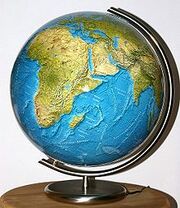
A globe is a three-dimensional scale model of Earth (terrestrial globe) or other spheroid celestial body such as a planet, star, or moon. It may also refer to a spherical representation of the celestial sphere, showing the apparent positions of the stars in the sky (celestial globe.) The word "globe" comes from the Latin word globus, meaning round mass or sphere.
Terrestrial and planetary globes[]
A Globe is the only that geographical representation that has negligible distortion over large areas; all flat maps are created using a map projection that inevitably introduces an increasing amount distortion the larger the area that the map shows. A typical scale for a terrestrial globe is roughly 1:40 million.
Sometimes a globe has relief, showing topography; in the case of a globe of the Earth the elevations are exaggerated, otherwise they would be hardly visible. Most modern globes are also imprinted with parallels and meridians so that one can (if only approximately due to scale) tell the coordinates of a specific point on the surface of the planet.
Celestial globes[]
Celestial globes show the apparent positions of the stars in the sky. They omit the Sun, Moon and planets because the positions of these bodies vary relative to those of the stars, but the ecliptic, along which the Sun moves, is indicated.
A potential issue arises regarding the "handedness" of celestial globes. If the globe is constructed so that the stars are in the positions they actually occupy on the imaginary celestial sphere, then the star field will appear back-to-front on the surface of the globe (all the constellations will appear as their mirror images). This is because the view from Earth, positioned at the centre of the celestial sphere, is of the inside of the celestial sphere, whereas the celestial globe is viewed from the outside. For this reason, celestial globes may be produced in mirror image, so that at least the constellations appear the "right way round". Some modern celestial globes address this problem by making the surface of the globe transparent. The stars can then be placed in their proper positions and viewed through the globe, so that the view is of the inside of the celestial sphere, as it is from Earth.
History[]
The earliest known globe was constructed by the Greek scholar Crates of Mallus in Cilicia (now Çukurova in modern-day Turkey) around 150 BCE. An ancient celestial globe that still exists was made about 150 CE as part of a sculpture, called the Farnese Atlas, in the Naples Museum, Naples, Italy.
The first terrestrial globe of the Old World was constructed in the Muslim world during the Middle Ages, by Muslim geographers and astronomers working under the Abbasid caliph, Al-Ma'mun, in the 9th century.
The oldest existing terrestrial globe was made by Martin Behaim in Nürnberg, Germany, in 1492. A facsimile globe showing America was made by Martin Waldseemueller in 1507. Another early globe, the Hunt-Lenox Globe, ca. 1507, is thought to be the source of the phrase "Here be dragons." Another "remarkably modern-looking" terrestrial globe of the Earth was constructed by Taqi al-Din at the Istanbul observatory of al-Din during the 1570s.
Manufacture[]
Mass-produced globes are typically covered by a printed paper map. The most common type has long, thin gores (strips) of paper that narrow to a point at the North Pole and the South Pole. Then a small disk is used to paper over the inevitable irregularities at the poles. The more gores there are, the less stretching and crumpling is required to make the paper map fit the sphere. From a geometric point of view, all points on a sphere are equivalent – one could select any arbitrary point on the Earth, and create a paper map that covers the Earth with strips that come together at that point and the antipodal point.
A globe is usually mounted at a 23.5° angle on bearings. In addition to making it easy to use this mounting also represents the angle of the planet in relation to its sun and the spin of the planet. This makes it easy to visualize how days and seasons change.